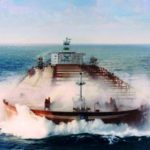
The performance of the West of Suez crude oil tanker segment confounded market participants’ expectations in the final quarter of 2024, with predictions that a seasonal increase in demand later in the year would increase prices failed to materialize.
In the VLCC market, sentiment remained bearish throughout the quarter, with sources pointing to ongoing OPEC+ production cuts and weak Chinese crude demand amid disappointing economic results and rising tonnage across key loading zones.
Platts, part of S&P Global Commodity Insights, rates freight on the 260,000 mt West Africa-Far East route at an average of w55 in the fourth quarter, with rates falling to a 14-month low of w45 on December 17.
Industry sources expressed differing opinions on the market outlook in 2025, with some expecting earnings to remain depressed, while others expect fundamentals to start moving back in favor of owners.
“No one sees much room for it [rates to increase] Currently, as demand from China is significantly lower, shipowners are sending their vessels to the West, while most of the Persian Gulf volumes are absorbed by Chinese tonnage,” said London-based broker VLCC. “Demand hasn’t completely declined, but it hasn’t been as high as we expected in the fourth quarter and I don’t see much change in the first quarter, because historically it’s not a good period. [for owners].”
“I feel things will change in January, with Saudi Arabia planning to lower its crude oil prices to increase demand in China,” said a second London-based VLCC broker. “I think tonnage will get tighter, and the AG market will impact WAF, though [US Gulf] tonnage is still in excess supply.”
With the VLCC fleet aging, many analysts point to lower rates set for compromised tonnage as another factor likely to dampen sentiment. However, a second VLCC broker argued that the prevalence of older vessels could start to benefit owners in the new year, leaving fewer fully operational vessels and therefore reducing tonnage supply.
Geopolitical developments could also significantly impact VLCC trade flows, following the US Treasury Department’s announcement on January 10 that it was sanctioning an additional 180 vessels involved in the illicit fleet. Sources said this could lead to China replacing Russian, Venezuelan and Iranian barrels with additional conventional shipments from the Persian Gulf, West Africa and US Gulf, which would provide support to prices in key VLCC markets.
Any significant deterioration in US-China relations during Trump’s upcoming term could also impact VLCC trade flows, as possible economic conflict between the two countries would likely cause disruption to US Gulf-China VLCC routes, according to Middle East-based shipbrokers. .
“[The market] will be political, and a lot depends on how Trump reacts – if he imposes higher import taxes on Chinese goods, then China will react similarly, which will create tensions that spill over into the shipping market,” the broker said.
Suezmax starts to recover after historic lows
West Suez The Suezmax market experienced volatility in the final quarter of the year, but holders ultimately proved unable to mount a sustained recovery from the lows seen in the third quarter.
Freight on the 135,000 mt WAF-UK/Continent route on 4 October peaked at a three-month high of w102.25, excluding EU Emissions Trading Scheme charges, but ended the year with a 16-month low of w67, n. includes EU ETS Fees.
“This is the lowest number I have seen since I started,” said London-based broker Suezmax. “The volume is good [bad] everywhere, and we have seen many ships anchoring in Eastern waters and returning to the West, because the volume of ships coming out of the Persian Gulf is very small, and this certainly does not help.”
However, following a post-holiday lull in activity that saw the WAF-UKC interest rate slide to w59, which is the lowest level since February 2022, an increase in cargo demand has helped lift sentiment, with market players expecting a recovery in interest rates.
“The market appears to be strengthening at the moment, with last week’s prices feeling like a bottom, so we are only looking upwards from those levels,” said a second London-based Suezmax broker. “Last week was very close [break-even point] for most owners, this is a cop-out, as most owners would rather hang on and quickly abandon the ship than repair the damage.”
Meanwhile, in the Mediterranean and Black Sea, stricter environmental regulations in 2025 will increase costs for shipowners undertaking short-haul voyages, with the EU ETS charge increasing from 40% of CO2 emissions to 70% in early January and the Mediterranean region set to became an Emission Control Area zone in May. Shipowners are likely to try to pass these additional costs on to charterers by demanding higher rates, which in turn could provide support to the Suezmax market more globally, according to Middle East-based shipbrokers.
Source: Platts




